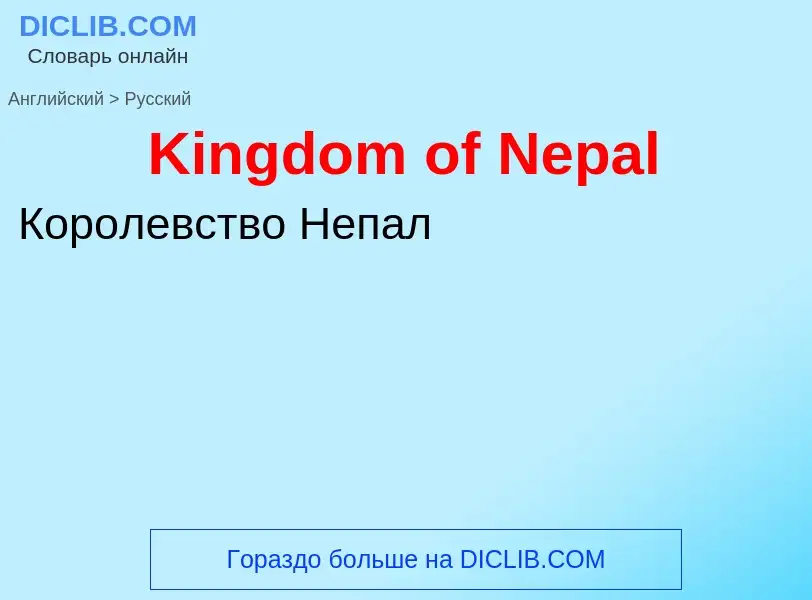Перевод и анализ слов искусственным интеллектом ChatGPT
На этой странице Вы можете получить подробный анализ слова или словосочетания, произведенный с помощью лучшей на сегодняшний день технологии искусственного интеллекта:
- как употребляется слово
- частота употребления
- используется оно чаще в устной или письменной речи
- варианты перевода слова
- примеры употребления (несколько фраз с переводом)
- этимология
Kingdom of Nepal - перевод на русский
[ni'pɔ:l]
существительное
география
Непал
Определение
.
Википедия

The Kingdom of Nepal (Nepali: नेपाल अधिराज्य), also known as the Gorkha Empire (Nepali: गोरखा अधिराज्य) or Asal Hindustan (Nepali: असल हिन्दुस्तान)(transl. Real Land of the Hindus), was a Hindu kingdom in South Asia, formed in 1768, by the unification of Nepal. Founded by King Prithvi Narayan Shah, a Gorkha monarch who claimed to be of Khas Thakuri origin, it existed for 240 years until the abolition of the Nepalese monarchy in 2008. During this period, Nepal was formally under the rule of the Shah dynasty, which exercised varying degrees of power during the kingdom's existence.
After the invasion of Tibet and plundering of Digarcha by Nepali forces under Prince Regent Bahadur Shah in 1792, the Dalai Lama and Chinese Ambans reported to the Chinese administration for military support. The Chinese and Tibetan forces under Fuk'anggan attacked Nepal but went for negotiations after failure at Nuwakot. Mulkaji Damodar Pande, who was the most influential among the four Kajis, was appointed after removal of Bahadur Shah. Chief Kaji (Mulkaji) Kirtiman Singh Basnyat, tried to protect king Girvan Yuddha Shah and keep former king, Rana Bahadur Shah away from Nepal. However, on 4 March 1804, the former king came back and took over as Mukhtiyar (premier) and Damodar Pande was then beheaded in Thankot. The 1806 Bhandarkhal massacre instigated upon the death of Rana Bahadur Shah, set forth the rise of authoritative Mukhtiyar Bhimsen Thapa, who became the de facto ruler of Nepal from 1806 to 1837. During the early nineteenth century, however, the expansion of the East India Company's rule in India led to the Anglo-Nepalese War (1814–1816), which resulted in Nepal's defeat. Under the Treaty of Sugauli, the kingdom retained its internal independence, but in exchange for territorial concessions, marking the Mechi and Sharda rivers as the boundary of Nepalese territories. The territory of the kingdom before the Sugauli treaty is sometimes nascently referred to as Greater Nepal. In the political scenario, the death of Mukhtiyar Mathbar Singh Thapa ended the Thapa hegemony and set the stage for the Kot massacre. This resulted in the ascendancy of the Rana dynasty of Khas (Chhetri) and made the office of the Prime Minister of Nepal hereditary in their family for the next century, from 1843 to 1951. Beginning with Jung Bahadur, the first Rana ruler, the Rana dynasty reduced the Shah monarch to a figurehead role. The Rana rule was marked by tyranny, debauchery, economic exploitation and religious persecution.
In July 1950, the newly independent Republic of India signed a friendship treaty in which both nations agreed to respect the other's sovereignty. In November of the same year, India played an important role in supporting King Tribhuvan, whom the Rana leader Mohan Shumsher Jang Bahadur Rana had attempted to depose and replace with his infant grandson who would later become King Gyanendra. With Indian support for a new government consisting largely of the Nepali Congress, King Tribhuvan ended the Rana regime in 1951.
Unsuccessful attempts were made to implement reforms and adopt a constitution during the 1960s and 1970s. An economic crisis at the end of the 1980s led to a popular movement that brought about parliamentary elections and the adoption of a constitutional monarchy in 1990. The 1990s saw the beginning of the Nepalese Civil War (1996–2006), a conflict between government forces and the insurgent forces of the Communist Party of Nepal (Maoist). The situation of the Nepalese monarchy was further destabilised by the 2001 Nepalese royal massacre.
As a result of the massacre, King Gyanendra returned to the throne. His imposition of direct rule in 2005 provoked a protest movement unifying the Maoist insurgency and pro-democracy activists. He was eventually forced to restore the House of Representatives, which in 2007 adopted an interim constitution greatly restricting the powers of the Nepalese monarchy. Following an election held the next year, the Nepalese Constituent Assembly formally abolished the kingdom in its first session on 28 May 2008, declaring the Federal Democratic Republic of Nepal in its place.
Until the abolition of the monarchy, Nepal was the world's only country to have Hinduism as its state religion; since becoming a republic, the country is now formally a secular state.


![Abhiman Singh Basnyat]], a military commander and later ''Mulkaji'' Abhiman Singh Basnyat]], a military commander and later ''Mulkaji''](https://commons.wikimedia.org/wiki/Special:FilePath/Abhiman Singh Basnyat.jpg?width=200)
![Kaji]]'' (equivalent to Prime Minister) of Gorkha; Commander of Gorkhali forces at victorious battle of Nuwakot Kaji]]'' (equivalent to Prime Minister) of Gorkha; Commander of Gorkhali forces at victorious battle of Nuwakot](https://commons.wikimedia.org/wiki/Special:FilePath/Bamshidhar Kalu Pande.jpg?width=200)
![''Mukhtiyar'' [[Bhimsen Thapa]], founder of Khas [[Thapa dynasty]] ''Mukhtiyar'' [[Bhimsen Thapa]], founder of Khas [[Thapa dynasty]]](https://commons.wikimedia.org/wiki/Special:FilePath/Bhimsen Thapa of Nepal (cropped).jpg?width=200)
![[[Damodar Pande]], ''Mulkaji'' of Nepal from the Pande aristocratic family [[Damodar Pande]], ''Mulkaji'' of Nepal from the Pande aristocratic family](https://commons.wikimedia.org/wiki/Special:FilePath/Damodar Pande.jpg?width=200)

![Gorkha]] Gorkha]]](https://commons.wikimedia.org/wiki/Special:FilePath/Kings Palace Gorkha Nepal.jpg?width=200)



